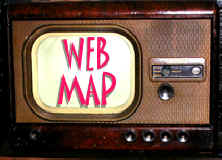|
|
And then there was... Du Mont. |
|
|
|
Until 1953 there were only two networks that really mattered. William Paley's CBS and David Sarnoff's NBC, which was part of his Radio Corporation of America dynasty. They had the big bucks, the vast talent pool culled from their profitable and well established radio networks, and of course the sponsors who salivated at the chance to have their products hawked in the new medium by top name celebrities. ABC was there but until Leonard Goldenson merged the network into his newly formed United Paramount Theaters in 1953, had neither the capital or the affiliates to compete with the big two. But there was for a time, a fourth network . No not Fox (but more on that later) but a small network of mostly UHF stations operated by the Allen B. Du Mont Laboratories. In television's pioneering days, Du Mont was a respected name, ranked up there with titans RCA, Philco, and Farnsworth. It is due to Du Mont's efforts with the "electronicam" filming system that we can enjoy the "classic 39" episodes of Jackie Gleason's "Honeymooners" series which was aired on CBS but filmed with Du Mont facilities. Pick up any newspaper of the day and you'll find the top line Du Mont televisions next to the most popular brands Motorola, Admiral, Zenith, and RCA Victor. But taking on the responsibilities of a television network may not have been in the company's best interest. Du Mont's problems were not entirely its own fault, but it starts there. As mentioned earlier, CBS and NBC, and to a lesser extent, ABC, had a regular roster of talent mainly from their radio networks. Du Mont had no such talent to draw upon. There wasn't much Du Mont could offer so the name stars naturally stayed away and since they stayed away- the sponsors were almost non-existent. With no money, no stars, and a limited number of stations, the network was hardset to find affiliates. It wasn't a total loss. Du Mont did offer some gems in its short life. It was on Du Mont that Jackie Gleason first honed his stable of characters on his variety series "Cavalcade Of Stars" in 1950. It was on this series that viewers got their first glimpse of a loud-mouthed bus driver named Ralph Kramden. Morey Amsterdam, later to achieve greater fame on The Dick Van Dyke Show, makes one of his earliest appearances on a series titled Admiral Broadway Revue. Children were not ignored by DuMont as Captain Video blasted off each afternoon. And Bishop Fulton Sheen opened the doors for future tele evangelists Billy Graham and Jerry Swaggert with his Sunday evening series Life is Worth Living. Sports also played a big role in DuMont's programming, especially boxing. Perhaps the most ironic achievement for Du Mont was that it was lucky enough to have the very first top-rated television program beating out CBS and NBC. In March of 1948, C.E. Hooper, the company that also did the ratings for radio shows, announced that "The Original Amateur Hour" was the number one network program. The talent show, hosted by Ted Mack, and brought the wonders of Geritol to our homes, had to be a huge morale boost for the upstart network who had no experience in programming. It also showed the industry and the country that television was for everyone and not just for the hoi polloi.
The remaining stations owned by Du Mont (forming the nucleuses of the network) were spun off into a separate company called The Du Mont Broadcasting Corporation. Because it was felt that the Du Mont name now carried a certain negativity to it, the company was changed to Metropolitan Broadcasting. Media mogul John Kluge purchased the remaining stock that Paramount Pictures held in Du Mont, (in a bit of irony since it was Paramount's involvement with Du Mont that contributed to the network's demise) and changed the company's name to Metromedia which continued to purchase and affiliate stations across the country. Eventually Rupert Murdoch, the Australian billionaire would purchase Metromedia and use it as the core for his upstart Fox Network in 1986. So you can say that Fox is a descendant of Du Mont.
|


